上周在看DASCTF的題發現難得有一道安卓( 題目名:RealeazyRealeazy ),興致勃勃地打開IDA卻發現了這可悲的控制流平坦化,當場直接自閉…
之後分析了下發現這ollvm應該算是比較簡單的那類( 只有間接跳轉 + 最普通的平坦化,貌似沒有虛假分支/虛假塊 ),於是決定好好地學習下怎麼還原。
一開始是想按「使用unidbg还原标准ollvm的fla控制流程平坦化」一樣使用Unidbg來還原,後面發現分支的情況用Unidbg不太好處理。
最後還是決定用Unicorn的模擬執行來還原,具體思路&實現完全參考「[原创]ARM64 OLLVM反混淆」。
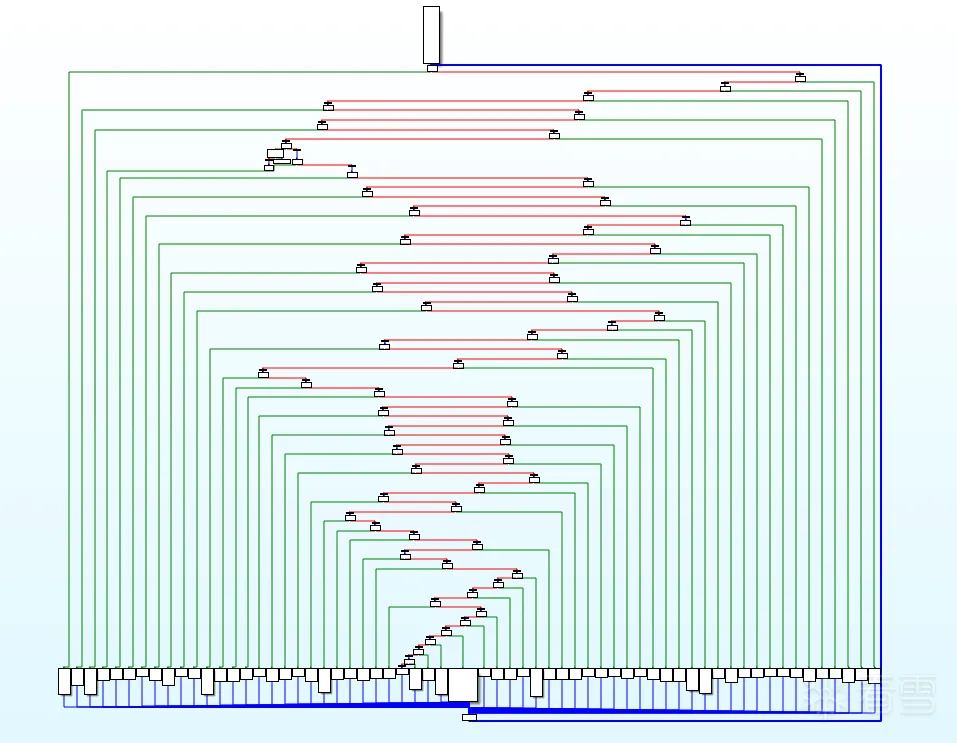
利用Unicorn來模擬執行,從而獲取程序的執行流程,主要有以下步驟:
首先是收集各種塊的邏輯,通過capstone來遍歷so文件,offset和end分別是某函數的起始、結束地址,block_list用來保存所有塊( 以塊的起始地址作為鍵,而值是包含當前塊各種信息的block_item )。
如何判斷塊的結尾?通過觀察so文件可以知道,一個塊要麼以mov pc, r0結束,要麼以b XXX結束,而前者更是真實塊的特徵。
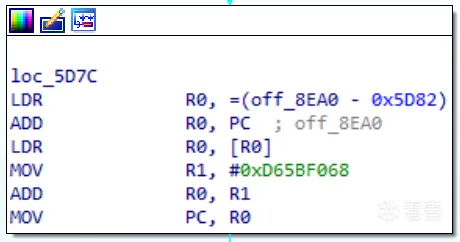
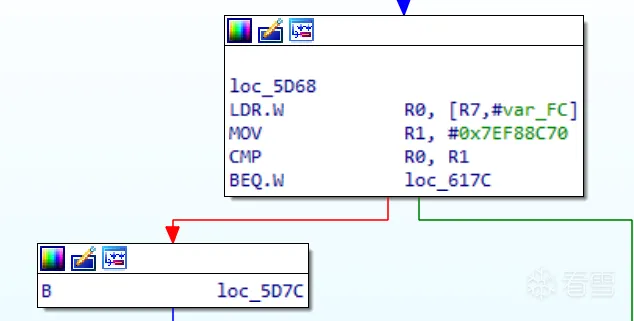
除了真實塊外,預處理塊也是以mov pc,r0結尾,顯然需要將其排除在外,不能讓其保存在real_blocks中。這裡我使用了IDA Python來提前找出所有預處理器的起始地址,實現思路是遍歷找出那些入度為n且出度為1 的塊( 很簡單但對本例很有效 )。
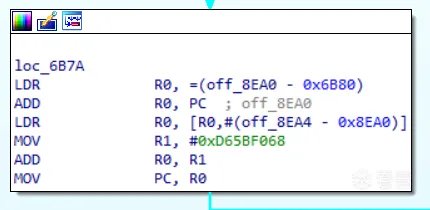
IDA Python script for finding preprocessor
具體實現代碼如下:
初始化Unicorn的模擬執行環境,這裡我們不需要考慮傳參之類的東西。hook_code是指令hook的回調函數,也是最關鍵的邏輯所在,後面會重點介紹。hook_mem_access是內存訪問異常時的回調,對本例的用處不大。
這裡設置.data節是因為程序的間接條跳依賴於其中的數據,若不添加程序將無法執行。
正式開始模擬執行,會模擬執行若干次,每次會從某真實塊出發,直到找到另一個真實塊/結束塊為至。
用queue來保存模擬執行的順序以及對應的上下文,保存上下文是因為分支要走兩條路,當走完一條分支時通過恢復上下文來達到一種回溯的效果,從而繼續走第二條分支。通過這種方法就能遍歷完所有可能的真實塊,但對於有虛假分支的情況,這樣做可能會導致死循環,但反過來想也是一種檢測虛假分支的思路。
itt是本例的真實塊裡的分支指令,具體處理的邏輯在hook_code中,這裡提前判斷的目的是為了手動控制分支的走向。
find_path的返回值是某真實塊的起始地址( 通過block_list能獲取該塊的所有信息 )。
在報錯時直接跳過導致報錯的指令( 通常是由於Unicorn不兼容某些指令所導致的報錯 ),可以直接跳過的原因是我們只關注會影響執行流的指令,其他無需理會。
要特別注意的是,本例是Thumb Mode,因此模擬執行的地址必須|1,否則會導致一連串奇怪的事情( 一開始沒留意被坑了很久…… )。
最關鍵的邏輯,主要分成以下幾部分:
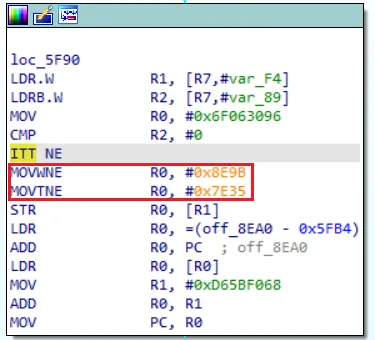
start_emu結束後的flow如下圖所示,很容易可以看到其中的規律,利用BFS來遍歷簡直再合適不過。

對於無分支的真實塊,可以直接通過b指令來跳轉,也可像我這樣修改r0來跳轉,因為本例本身就是將r0賦給pc來實現間接跳轉的,同時需要將一些字節patch為nop以防被干擾。
分支是像cmp r0,0; itt ne這樣的組合,只需將itt nepatch成bne addr1; b addr2就可以。傳入的addr就是itt ne的地址。
對於條件跳轉如beq、bne等,其跳轉的地址 = 目標地址 - 當前地址 - 4;而無條件跳轉直接跳到對應的絕對地址就可以。
條件跳轉後面跟的地址是b1_addr,這是True分支的真實塊的地址,這樣的處理是為了對應上述hook_code對分支的處理,兩者是有聯系的,不能隨便來。
最後附上一張還原的效果圖,以及上述如果有誤的話還望指出!!
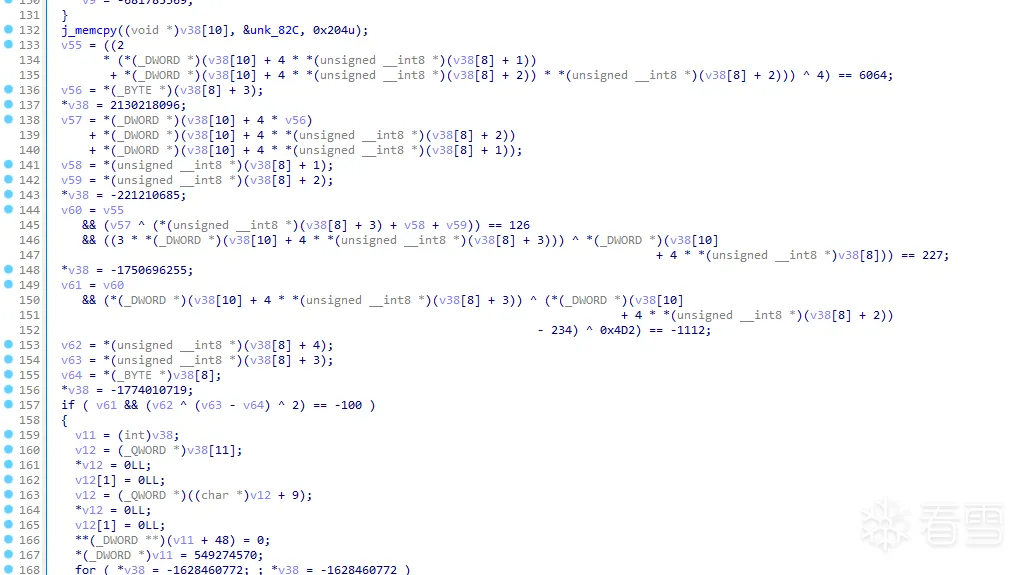
import ida_xref
import idc
import ida_segment
def get_all_cref_to(addr):
all_xref = []
ref = ida_xref.get_first_cref_to(addr)
while ref != 0xffffffff:
all_xref.append(ref)
ref = ida_xref.get_next_cref_to(addr, ref)
return all_xref
def get_all_cref_from(addr):
all_xref = []
ref = ida_xref.get_first_cref_from(addr)
while ref != 0xffffffff:
all_xref.append(ref)
ref = ida_xref.get_next_cref_from(addr, ref)
return all_xref
def is_preproc(addr):
all_xref_to = get_all_cref_to(addr)
all_xref_from = get_all_cref_from(addr)
return len(all_xref_to) > 5 and len(all_xref_from) == 1
preproc_addr_list = []
def get_preprocessor(seg):
global preproc_addr_list
print("====================================")
addr = seg.start_ea
end_addr = seg.end_ea
while addr < end_addr:
if is_preproc(addr):
preproc_addr_list.append(addr)
addr = idc.next_head(addr)
def main():
get_preprocessor(ida_segment.get_segm_by_name('.mytext'))
get_preprocessor(ida_segment.get_segm_by_name('.text'))
print(preproc_addr_list)
main()
import ida_xref
import idc
import ida_segment
def get_all_cref_to(addr):
all_xref = []
ref = ida_xref.get_first_cref_to(addr)
while ref != 0xffffffff:
all_xref.append(ref)
ref = ida_xref.get_next_cref_to(addr, ref)
return all_xref
def get_all_cref_from(addr):
all_xref = []
ref = ida_xref.get_first_cref_from(addr)
while ref != 0xffffffff:
all_xref.append(ref)
ref = ida_xref.get_next_cref_from(addr, ref)
return all_xref
def is_preproc(addr):
all_xref_to = get_all_cref_to(addr)
all_xref_from = get_all_cref_from(addr)
return len(all_xref_to) > 5 and len(all_xref_from) == 1
preproc_addr_list = []
def get_preprocessor(seg):
global preproc_addr_list
print("====================================")
addr = seg.start_ea
end_addr = seg.end_ea
while addr < end_addr:
if is_preproc(addr):
preproc_addr_list.append(addr)
addr = idc.next_head(addr)
def main():
get_preprocessor(ida_segment.get_segm_by_name('.mytext'))
get_preprocessor(ida_segment.get_segm_by_name('.text'))
print(preproc_addr_list)
main()
def collect_blocks(offset, end, ret_addr):
global block_list
global real_blocks
global ret_blocks
global md
block_list = {}
real_blocks = []
ret_blocks = []
md = Cs(CS_ARCH_ARM, CS_MODE_THUMB)
md.detail = True
preproc_flag = False
ins_str = ""
is_new = True
for dasm in md.disasm(sodata[offset:end], offset):
if dasm.address >= 0x612E and dasm.address < 0x617C:
continue
ins_str += f"{hex(dasm.address)}:\t{dasm.mnemonic}\t{dasm.op_str}\n"
if is_new:
is_new = False
block_item = {}
block_item["start_addr"] = dasm.address
block_item["capstone"] = dasm
if is_preproc(dasm.address):
preproc_flag = True
if is_block_end(dasm):
is_new = True
block_item["end_addr"] = dasm.address
block_item["ins_str"] = ins_str
ins_str = ""
block_list[block_item["start_addr"]] = block_item
if dasm.mnemonic == "mov" and dasm.op_str == "pc, r0":
if preproc_flag:
preproc_flag = False
else:
real_blocks.append(block_item["start_addr"])
ret_blocks.append(ret_addr)
def is_block_end(dasm):
if dasm.mnemonic == "mov" and dasm.op_str == "pc, r0":
return True
if dasm.mnemonic == "b":
return True
return False
def is_preproc(addr):
preprocessor_addrs = [27514, 3200, 5784, 10490, 15456, 17002, 19836, 20578, 22440]
return addr in preprocessor_addrs
def collect_blocks(offset, end, ret_addr):
global block_list
global real_blocks
global ret_blocks
global md
block_list = {}
real_blocks = []
ret_blocks = []
md = Cs(CS_ARCH_ARM, CS_MODE_THUMB)
md.detail = True
preproc_flag = False
ins_str = ""
is_new = True
for dasm in md.disasm(sodata[offset:end], offset):
if dasm.address >= 0x612E and dasm.address < 0x617C:
continue
ins_str += f"{hex(dasm.address)}:\t{dasm.mnemonic}\t{dasm.op_str}\n"
if is_new:
is_new = False
block_item = {}
block_item["start_addr"] = dasm.address
block_item["capstone"] = dasm
if is_preproc(dasm.address):
preproc_flag = True
if is_block_end(dasm):
is_new = True
block_item["end_addr"] = dasm.address
block_item["ins_str"] = ins_str
ins_str = ""
block_list[block_item["start_addr"]] = block_item
if dasm.mnemonic == "mov" and dasm.op_str == "pc, r0":
if preproc_flag:
preproc_flag = False
else:
real_blocks.append(block_item["start_addr"])
ret_blocks.append(ret_addr)
def is_block_end(dasm):
if dasm.mnemonic == "mov" and dasm.op_str == "pc, r0":
return True
if dasm.mnemonic == "b":
return True
return False
def is_preproc(addr):
preprocessor_addrs = [27514, 3200, 5784, 10490, 15456, 17002, 19836, 20578, 22440]
return addr in preprocessor_addrs
def init_unicorn(filename):
global mu
global sodata
if isinstance(sodata, bytearray):
sodata = bytes(sodata)
mu = Uc(UC_ARCH_ARM, UC_MODE_THUMB)
mu.mem_map(0x80000000, 0x1000 * 8)
mu.mem_map(0, 4 * 1024 * 1024)
mu.mem_write(0, sodata)
mu.reg_write(UC_ARM_REG_SP, 0x80000000 + 0x1000 * 4)
mu.hook_add(UC_HOOK_CODE, hook_code)
mu.hook_add(UC_HOOK_MEM_UNMAPPED, hook_mem_access)
data_section = get_section(filename, '.data')
DATA_MEM_OFFSET = data_section.header["sh_addr"]
DATA_FILE_OFFSET = data_section.header["sh_offset"]
DATA_SIZE = data_section.header["sh_size"]
mu.mem_write(DATA_MEM_OFFSET, sodata[DATA_FILE_OFFSET:DATA_FILE_OFFSET+DATA_SIZE])
def init_unicorn(filename):
global mu
global sodata
if isinstance(sodata, bytearray):
sodata = bytes(sodata)
mu = Uc(UC_ARCH_ARM, UC_MODE_THUMB)
mu.mem_map(0x80000000, 0x1000 * 8)
mu.mem_map(0, 4 * 1024 * 1024)
mu.mem_write(0, sodata)
mu.reg_write(UC_ARM_REG_SP, 0x80000000 + 0x1000 * 4)
mu.hook_add(UC_HOOK_CODE, hook_code)
mu.hook_add(UC_HOOK_MEM_UNMAPPED, hook_mem_access)
data_section = get_section(filename, '.data')
DATA_MEM_OFFSET = data_section.header["sh_addr"]
DATA_FILE_OFFSET = data_section.header["sh_offset"]
DATA_SIZE = data_section.header["sh_size"]
mu.mem_write(DATA_MEM_OFFSET, sodata[DATA_FILE_OFFSET:DATA_FILE_OFFSET+DATA_SIZE])
def start_emu(offset):
global is_success
global flow
if offset in real_blocks:
real_blocks.remove(offset)
queue = [(offset, None)]
flow = {}
is_success = False
while len(queue) != 0:
env = queue.pop()
pc = env[0]
set_context(env[1])
item = block_list[pc]
if pc in flow:
continue
flow[pc] = []
if item["ins_str"].find("itt") != -1:
ctx = get_context()
p1 = find_path(pc, 0)
if p1 != None:
queue.append((p1, get_context()))
flow[pc].append(p1)
set_context(ctx)
p2 = find_path(pc, 1)
if p1 != p2:
queue.append((p2, get_context()))
flow[pc].append(p2)
else:
p = find_path(pc)
if p != None:
queue.append((p, get_context()))
flow[pc].append(p)
def start_emu(offset):
global is_success
global flow
if offset in real_blocks:
real_blocks.remove(offset)
queue = [(offset, None)]
flow = {}
is_success = False
while len(queue) != 0:
env = queue.pop()
pc = env[0]
set_context(env[1])
item = block_list[pc]
if pc in flow:
continue
flow[pc] = []
if item["ins_str"].find("itt") != -1:
ctx = get_context()
p1 = find_path(pc, 0)
if p1 != None:
queue.append((p1, get_context()))
flow[pc].append(p1)
set_context(ctx)
p2 = find_path(pc, 1)
if p1 != p2:
queue.append((p2, get_context()))
flow[pc].append(p2)
else:
p = find_path(pc)
if p != None:
queue.append((p, get_context()))
flow[pc].append(p)
def find_path(start_addr, branch = None):
global real_blocks
global mu
global g_start_addr
global branch_control
global list_trace
global dst_addr
global is_success
branch_control = branch
g_start_addr = start_addr
list_trace = {}
dst_addr = 0
is_success = False
try:
mu.emu_start(start_addr | 1, start_addr + 0x10000)
print("============= emu end =============")
except UcError as e:
pc = mu.reg_read(UC_ARM_REG_PC)
if pc != 0:
_size = get_ins_size(pc)
return find_path(pc + _size, branch)
else:
print("ERROR: %s pc:%x" % (e,pc))
if is_success:
return dst_addr
return None
def find_path(start_addr, branch = None):
global real_blocks
global mu
global g_start_addr
global branch_control
global list_trace
global dst_addr
global is_success
branch_control = branch
g_start_addr = start_addr
list_trace = {}
dst_addr = 0
is_success = False
try:
mu.emu_start(start_addr | 1, start_addr + 0x10000)
print("============= emu end =============")
except UcError as e:
pc = mu.reg_read(UC_ARM_REG_PC)
if pc != 0:
_size = get_ins_size(pc)
return find_path(pc + _size, branch)
else:
print("ERROR: %s pc:%x" % (e,pc))
if is_success:
return dst_addr
return None
def hook_code(uc, address, size, user_data):
global is_success
global mu
global branch_control
global g_start_addr
global list_trace
global dst_addr
global end
global md
if is_success or address > end:
mu.emu_stop()
return
ban_ins = ["bl", "blx"]
if address in [0x5ED6]:
print("debug addr: ", hex(address))
for ins in md.disasm(sodata[address:address+size], address):
print(">>> Tracing instruction at 0x%x, instruction size = 0x%x" % (address, size))
print(">>> 0x%x:\t%s\t%s\t%d" % (ins.address, ins.mnemonic, ins.op_str, ins.size))
print_regs()
if address in real_blocks:
if address in list_trace:
print("have fake block?")
uc.emu_stop()
else:
list_trace[address] = 1
if address != g_start_addr:
is_success = True
dst_addr = address
print(f"find: {hex(address)}")
uc.emu_stop()
return
if address in ret_blocks:
print(f"end_block: {hex(address)} ")
mu.emu_stop()
return
flag_pass = False
for b in ban_ins:
if ins.mnemonic.find(b) != -1:
flag_pass = True
break
if ins.op_str.find("[") != -1:
if ins.op_str.find("[r7") != -1 and ins.op_str.find("0xf4") != -1:
print()
if ins.op_str.find("[sp") != -1:
flag_pass = True
for op in ins.operands:
if op.type == ARM_OP_MEM:
reg_name = ins.reg_name(op.value.base)
addr = mu.reg_read(reg_ctou(reg_name))
if addr >= 0x80000000 and addr < 0x80000000 + 0x10000 * 8:
flag_pass = False
if flag_pass:
print(f"[pass] addr: {hex(ins.address)} size: {ins.size}")
uc.reg_write(UC_ARM_REG_PC, (ins.address + ins.size) | 1)
return
if branch_control == None:
return
next_dasm = get_dasm(ins.address + ins.size, 4)
if next_dasm.mnemonic == "itt" and next_dasm.op_str == "ne":
if ins.mnemonic == "cmp":
ops = ins.op_str.split(", ")
reg = reg_ctou(ops[0])
if ops[1].startswith("#"):
cmp_num = int(ops[1][1:], 16)
else:
assert ops[1].startswith("r")
cmp_num = mu.reg_read(reg_ctou(ops[1]))
if branch_control == 0:
mu.reg_write(reg, cmp_num)
else:
mu.reg_write(reg, cmp_num + 1)
elif ins.mnemonic == "tst":
regs = [reg_ctou(x) for x in ins.op_str.split(", ")]
if branch_control == 0:
mu.reg_write(regs[0], 0)
mu.reg_write(regs[1], 0)
else:
mu.reg_write(regs[0], 1)
mu.reg_write(regs[1], 1)
elif next_dasm.mnemonic == "itt" and next_dasm.op_str == "lt" or \
next_dasm.mnemonic == "itt" and next_dasm.op_str == "mi" or \
next_dasm.mnemonic == "itt" and next_dasm.op_str == "lo":
if ins.mnemonic == "cmp":
ops = ins.op_str.split(", ")
reg = reg_ctou(ops[0])
if ops[1].startswith("#"):
cmp_num = int(ops[1][1:], 16)
else:
assert ops[1].startswith("r")
cmp_num = mu.reg_read(reg_ctou(ops[1]))
if branch_control == 0:
mu.reg_write(reg, cmp_num + 1)
else:
mu.reg_write(reg, cmp_num - 1)
elif next_dasm.mnemonic == "itt" and next_dasm.op_str == "gt":
if ins.mnemonic == "cmp":
ops = ins.op_str.split(", ")
reg = reg_ctou(ops[0])
if ops[1].startswith("#"):
cmp_num = int(ops[1][1:], 16)
else:
assert ops[1].startswith("r")
cmp_num = mu.reg_read(reg_ctou(ops[1]))
if branch_control == 0:
mu.reg_write(reg, cmp_num - 1)
else:
mu.reg_write(reg, cmp_num + 1)
elif next_dasm.mnemonic == "itt" and next_dasm.op_str == "eq":
if ins.mnemonic == "cmp":
ops = ins.op_str.split(", ")
reg = reg_ctou(ops[0])
if ops[1].startswith("#"):
cmp_num = int(ops[1][1:], 16)
else:
assert ops[1].startswith("r")
cmp_num = mu.reg_read(reg_ctou(ops[1]))
if branch_control == 0:
mu.reg_write(reg, cmp_num - 1)
else:
mu.reg_write(reg, cmp_num)
elif next_dasm.mnemonic == "itt":
raise Exception("ollvm branch new type")
def hook_code(uc, address, size, user_data):
global is_success
global mu
global branch_control
global g_start_addr
global list_trace
global dst_addr
global end
global md
if is_success or address > end:
mu.emu_stop()
return
ban_ins = ["bl", "blx"]
if address in [0x5ED6]:
print("debug addr: ", hex(address))
for ins in md.disasm(sodata[address:address+size], address):
print(">>> Tracing instruction at 0x%x, instruction size = 0x%x" % (address, size))
print(">>> 0x%x:\t%s\t%s\t%d" % (ins.address, ins.mnemonic, ins.op_str, ins.size))
print_regs()
if address in real_blocks:
if address in list_trace:
print("have fake block?")
uc.emu_stop()
else:
list_trace[address] = 1
if address != g_start_addr:
is_success = True
dst_addr = address
print(f"find: {hex(address)}")
uc.emu_stop()
return
if address in ret_blocks:
print(f"end_block: {hex(address)} ")
mu.emu_stop()
return
flag_pass = False
for b in ban_ins:
if ins.mnemonic.find(b) != -1:
flag_pass = True
break
if ins.op_str.find("[") != -1:
if ins.op_str.find("[r7") != -1 and ins.op_str.find("0xf4") != -1:
print()
if ins.op_str.find("[sp") != -1:
flag_pass = True
for op in ins.operands:
if op.type == ARM_OP_MEM:
reg_name = ins.reg_name(op.value.base)
addr = mu.reg_read(reg_ctou(reg_name))
if addr >= 0x80000000 and addr < 0x80000000 + 0x10000 * 8:
flag_pass = False
if flag_pass:
print(f"[pass] addr: {hex(ins.address)} size: {ins.size}")
uc.reg_write(UC_ARM_REG_PC, (ins.address + ins.size) | 1)
return
if branch_control == None:
return
next_dasm = get_dasm(ins.address + ins.size, 4)
if next_dasm.mnemonic == "itt" and next_dasm.op_str == "ne":
if ins.mnemonic == "cmp":
ops = ins.op_str.split(", ")
reg = reg_ctou(ops[0])
if ops[1].startswith("#"):
cmp_num = int(ops[1][1:], 16)
else:
assert ops[1].startswith("r")
cmp_num = mu.reg_read(reg_ctou(ops[1]))
if branch_control == 0:
mu.reg_write(reg, cmp_num)
else:
mu.reg_write(reg, cmp_num + 1)
elif ins.mnemonic == "tst":
regs = [reg_ctou(x) for x in ins.op_str.split(", ")]
if branch_control == 0:
mu.reg_write(regs[0], 0)
mu.reg_write(regs[1], 0)
else:
mu.reg_write(regs[0], 1)
mu.reg_write(regs[1], 1)
elif next_dasm.mnemonic == "itt" and next_dasm.op_str == "lt" or \
next_dasm.mnemonic == "itt" and next_dasm.op_str == "mi" or \
next_dasm.mnemonic == "itt" and next_dasm.op_str == "lo":
if ins.mnemonic == "cmp":
ops = ins.op_str.split(", ")
reg = reg_ctou(ops[0])
if ops[1].startswith("#"):
cmp_num = int(ops[1][1:], 16)
else:
assert ops[1].startswith("r")
cmp_num = mu.reg_read(reg_ctou(ops[1]))
if branch_control == 0:
mu.reg_write(reg, cmp_num + 1)
else:
mu.reg_write(reg, cmp_num - 1)
elif next_dasm.mnemonic == "itt" and next_dasm.op_str == "gt":
if ins.mnemonic == "cmp":
ops = ins.op_str.split(", ")
reg = reg_ctou(ops[0])
if ops[1].startswith("#"):
cmp_num = int(ops[1][1:], 16)
else:
assert ops[1].startswith("r")
cmp_num = mu.reg_read(reg_ctou(ops[1]))
if branch_control == 0:
mu.reg_write(reg, cmp_num - 1)
else:
mu.reg_write(reg, cmp_num + 1)
elif next_dasm.mnemonic == "itt" and next_dasm.op_str == "eq":
if ins.mnemonic == "cmp":
ops = ins.op_str.split(", ")
reg = reg_ctou(ops[0])
if ops[1].startswith("#"):
cmp_num = int(ops[1][1:], 16)
else:
assert ops[1].startswith("r")
cmp_num = mu.reg_read(reg_ctou(ops[1]))
if branch_control == 0:
mu.reg_write(reg, cmp_num - 1)
else:
mu.reg_write(reg, cmp_num)
elif next_dasm.mnemonic == "itt":
raise Exception("ollvm branch new type")
def start_patch(flow, start_addr):
global block_list
global sodata
sodata = bytearray(sodata)
visited = {}
queue = [start_addr]
while len(queue) != 0:
current_addr = queue.pop()
if current_addr in visited or current_addr == None:
continue
visited[current_addr] = 1
next_blocks = flow[current_addr]
rb_end_addr = block_list[current_addr]["end_addr"]
rb_start_addr = block_list[current_addr]["start_addr"]
if len(next_blocks) == 1:
queue.append(next_blocks[0])
patch_addr = rb_end_addr - 10
next_start_addr = queue[-1]
patch_nop(patch_addr, 10)
if next_start_addr != None:
asm_bytes = ks_asm(KS_ARCH_ARM, KS_MODE_THUMB, f"mov r0, #{hex(next_start_addr)}")
patch_bytes(patch_addr, asm_bytes)
print(f"{hex(patch_addr)} ---> {hex(next_start_addr)}")
else:
ret_block_addr = ret_blocks[0]
asm_bytes = ks_asm(KS_ARCH_ARM, KS_MODE_THUMB, f"mov r0, #{hex(ret_block_addr)}")
patch_bytes(patch_addr, asm_bytes)
print(f"{hex(patch_addr)} ---> ret block: {hex(ret_block_addr)}")
else:
queue.append(next_blocks[0])
queue.append(next_blocks[1])
b0 = next_blocks[0]
b1 = next_blocks[1]
patch_addr = get_branch_pa(rb_start_addr)
patch_branch(patch_addr, b0, b1)
print(f"{hex(patch_addr)} --->\n\t1. {hex(b0)}\n\t2. {hex(b1)}")
def start_patch(flow, start_addr):
global block_list
global sodata
sodata = bytearray(sodata)
visited = {}
queue = [start_addr]
while len(queue) != 0:
current_addr = queue.pop()
if current_addr in visited or current_addr == None:
continue
visited[current_addr] = 1
next_blocks = flow[current_addr]
rb_end_addr = block_list[current_addr]["end_addr"]
rb_start_addr = block_list[current_addr]["start_addr"]
if len(next_blocks) == 1:
queue.append(next_blocks[0])
patch_addr = rb_end_addr - 10
next_start_addr = queue[-1]
patch_nop(patch_addr, 10)
if next_start_addr != None:
asm_bytes = ks_asm(KS_ARCH_ARM, KS_MODE_THUMB, f"mov r0, #{hex(next_start_addr)}")
patch_bytes(patch_addr, asm_bytes)
print(f"{hex(patch_addr)} ---> {hex(next_start_addr)}")
else:
ret_block_addr = ret_blocks[0]
asm_bytes = ks_asm(KS_ARCH_ARM, KS_MODE_THUMB, f"mov r0, #{hex(ret_block_addr)}")
patch_bytes(patch_addr, asm_bytes)
print(f"{hex(patch_addr)} ---> ret block: {hex(ret_block_addr)}")
else:
queue.append(next_blocks[0])
queue.append(next_blocks[1])
b0 = next_blocks[0]
b1 = next_blocks[1]
patch_addr = get_branch_pa(rb_start_addr)
patch_branch(patch_addr, b0, b1)
print(f"{hex(patch_addr)} --->\n\t1. {hex(b0)}\n\t2. {hex(b1)}")
def patch_branch(addr, b0, b1):
dasm = get_dasm(addr, 4)
assert dasm.mnemonic == "itt"
print(f"{hex(addr)}:\t{dasm.mnemonic}\t{dasm.op_str}")
patch_nop(addr, 28 + 2)
b1_addr = b1 - addr - 4
b0_addr = b0
branch_true_bytes = ks_asm(KS_ARCH_ARM, KS_MODE_THUMB, f"b{dasm.op_str} #{hex(b1_addr)}", addr)
branch_false_bytes = ks_asm(KS_ARCH_ARM, KS_MODE_THUMB, f"b {hex(b0_addr)}", addr + len(branch_true_bytes))
patch_bytes(addr, branch_true_bytes)
patch_bytes(addr + len(branch_true_bytes), branch_false_bytes)
def patch_branch(addr, b0, b1):
dasm = get_dasm(addr, 4)
assert dasm.mnemonic == "itt"
print(f"{hex(addr)}:\t{dasm.mnemonic}\t{dasm.op_str}")
patch_nop(addr, 28 + 2)
b1_addr = b1 - addr - 4
b0_addr = b0
branch_true_bytes = ks_asm(KS_ARCH_ARM, KS_MODE_THUMB, f"b{dasm.op_str} #{hex(b1_addr)}", addr)
branch_false_bytes = ks_asm(KS_ARCH_ARM, KS_MODE_THUMB, f"b {hex(b0_addr)}", addr + len(branch_true_bytes))
patch_bytes(addr, branch_true_bytes)
patch_bytes(addr + len(branch_true_bytes), branch_false_bytes)
from capstone import *
from capstone.arm import *
from unicorn import *
from unicorn.arm_const import *
from keystone import *
from elftools.elf.elffile import ELFFile
def get_section(filename, sectionName):
file = open(filename, 'rb')
elf_file = ELFFile(file)
for section in elf_file.iter_sections():
if section.name == sectionName:
return section
def reg_ctou(reg_name):
if reg_name == "sp":
return UC_ARM_REG_SP
if reg_name == "pc":
return UC_ARM_REG_PC
reg_idx = int(reg_name[1:])
if reg_idx >= 0 and reg_idx <= 12:
return UC_ARM_REG_R0 + reg_idx
raise Exception("reg_ctou: have new type?")
def is_block_end(dasm):
if dasm.mnemonic == "mov" and dasm.op_str == "pc, r0":
return True
if dasm.mnemonic == "b":
return True
return False
def hook_mem_access(uc, type, address,size,value,userdata):
pc = uc.reg_read(UC_ARM_REG_PC)
print('pc:%x type:%d addr:%x size:%x' % (pc, type, address, size))
return True
def is_preproc(addr):
preprocessor_addrs = [27514, 3200, 5784, 10490, 15456, 17002, 19836, 20578, 22440]
return addr in preprocessor_addrs
def get_context():
global mu
return mu.context_save()
def set_context(context):
global mu
if context == None:
return
mu.context_restore(context)
def print_regs():
global mu
msg = ""
for i in range(8):
msg += f"r{i}:{hex(mu.reg_read(UC_ARM_REG_R0 + i))}\t"
msg += f"sp:{hex(mu.reg_read(UC_ARM_REG_SP))}\tpc:{hex(mu.reg_read(UC_ARM_REG_PC))}"
print(msg)
def get_ins_size(addr):
for ins in md.disasm(sodata[addr:addr+4], addr):
return ins.size
def get_dasm(addr, size):
global md
global sodata
for dasm in md.disasm(sodata[addr:addr+size], addr):
return dasm
def hook_code(uc, address, size, user_data):
global is_success
global mu
global branch_control
global g_start_addr
global list_trace
global dst_addr
global end
global md
if is_success or address > end:
mu.emu_stop()
return
ban_ins = ["bl", "blx"]
if address in [0x5ED6]:
print("debug addr: ", hex(address))
for ins in md.disasm(sodata[address:address+size], address):
print(">>> Tracing instruction at 0x%x, instruction size = 0x%x" % (address, size))
print(">>> 0x%x:\t%s\t%s\t%d" % (ins.address, ins.mnemonic, ins.op_str, ins.size))
print_regs()
if address in real_blocks:
if address in list_trace:
print("have fake block?")
uc.emu_stop()
else:
list_trace[address] = 1
if address != g_start_addr:
is_success = True
dst_addr = address
print(f"find: {hex(address)}")
uc.emu_stop()
return
if address in ret_blocks:
print(f"end_block: {hex(address)} ")
mu.emu_stop()
return
flag_pass = False
for b in ban_ins:
if ins.mnemonic.find(b) != -1:
flag_pass = True
break
if ins.op_str.find("[") != -1:
if ins.op_str.find("[r7") != -1 and ins.op_str.find("0xf4") != -1:
print()
if ins.op_str.find("[sp") != -1:
flag_pass = True
for op in ins.operands:
if op.type == ARM_OP_MEM:
reg_name = ins.reg_name(op.value.base)
addr = mu.reg_read(reg_ctou(reg_name))
if addr >= 0x80000000 and addr < 0x80000000 + 0x10000 * 8:
flag_pass = False
if flag_pass:
print(f"[pass] addr: {hex(ins.address)} size: {ins.size}")
uc.reg_write(UC_ARM_REG_PC, (ins.address + ins.size) | 1)
return
if branch_control == None:
return
next_dasm = get_dasm(ins.address + ins.size, 4)
if next_dasm.mnemonic == "itt" and next_dasm.op_str == "ne":
if ins.mnemonic == "cmp":
ops = ins.op_str.split(", ")
reg = reg_ctou(ops[0])
if ops[1].startswith("#"):
cmp_num = int(ops[1][1:], 16)
else:
assert ops[1].startswith("r")
cmp_num = mu.reg_read(reg_ctou(ops[1]))
if branch_control == 0:
mu.reg_write(reg, cmp_num)
else:
mu.reg_write(reg, cmp_num + 1)
elif ins.mnemonic == "tst":
regs = [reg_ctou(x) for x in ins.op_str.split(", ")]
if branch_control == 0:
mu.reg_write(regs[0], 0)
mu.reg_write(regs[1], 0)
else:
mu.reg_write(regs[0], 1)
mu.reg_write(regs[1], 1)
elif next_dasm.mnemonic == "itt" and next_dasm.op_str == "lt" or \
next_dasm.mnemonic == "itt" and next_dasm.op_str == "mi" or \
next_dasm.mnemonic == "itt" and next_dasm.op_str == "lo":
if ins.mnemonic == "cmp":
ops = ins.op_str.split(", ")
reg = reg_ctou(ops[0])
if ops[1].startswith("#"):
cmp_num = int(ops[1][1:], 16)
else:
assert ops[1].startswith("r")
cmp_num = mu.reg_read(reg_ctou(ops[1]))
if branch_control == 0:
mu.reg_write(reg, cmp_num + 1)
else:
mu.reg_write(reg, cmp_num - 1)
elif next_dasm.mnemonic == "itt" and next_dasm.op_str == "gt":
if ins.mnemonic == "cmp":
ops = ins.op_str.split(", ")
reg = reg_ctou(ops[0])
if ops[1].startswith("#"):
cmp_num = int(ops[1][1:], 16)
else:
assert ops[1].startswith("r")
cmp_num = mu.reg_read(reg_ctou(ops[1]))
if branch_control == 0:
mu.reg_write(reg, cmp_num - 1)
else:
mu.reg_write(reg, cmp_num + 1)
elif next_dasm.mnemonic == "itt" and next_dasm.op_str == "eq":
if ins.mnemonic == "cmp":
ops = ins.op_str.split(", ")
reg = reg_ctou(ops[0])
if ops[1].startswith("#"):
cmp_num = int(ops[1][1:], 16)
else:
assert ops[1].startswith("r")
cmp_num = mu.reg_read(reg_ctou(ops[1]))
if branch_control == 0:
mu.reg_write(reg, cmp_num - 1)
else:
mu.reg_write(reg, cmp_num)
elif next_dasm.mnemonic == "itt":
raise Exception("ollvm branch new type")
def find_path(start_addr, branch = None):
global real_blocks
global mu
global g_start_addr
global branch_control
global list_trace
global dst_addr
global is_success
branch_control = branch
g_start_addr = start_addr
list_trace = {}
dst_addr = 0
is_success = False
try:
mu.emu_start(start_addr | 1, start_addr + 0x10000)
print("============= emu end =============")
except UcError as e:
pc = mu.reg_read(UC_ARM_REG_PC)
if pc != 0:
_size = get_ins_size(pc)
return find_path(pc + _size, branch)
else:
print("ERROR: %s pc:%x" % (e,pc))
if is_success:
return dst_addr
return None
def patch_nop(addr, size):
global sodata
nop_bytes = bytearray(b'\x00\xbf')
for i in range(size):
sodata[addr + i] = nop_bytes[i % 2]
def patch_bytes(addr, bytes: bytearray):
for i in range(len(bytes)):
sodata[addr + i] = bytes[i]
def ks_asm(arch, mode, code, addr = 0):
ks = Ks(arch, mode)
encoding, count = ks.asm(code, addr)
return bytearray(encoding)
def patch_branch(addr, b0, b1):
dasm = get_dasm(addr, 4)
assert dasm.mnemonic == "itt"
print(f"{hex(addr)}:\t{dasm.mnemonic}\t{dasm.op_str}")
patch_nop(addr, 28 + 2)
b1_addr = b1 - addr - 4
b0_addr = b0
branch_true_bytes = ks_asm(KS_ARCH_ARM, KS_MODE_THUMB, f"b{dasm.op_str} #{hex(b1_addr)}", addr)
branch_false_bytes = ks_asm(KS_ARCH_ARM, KS_MODE_THUMB, f"b {hex(b0_addr)}", addr + len(branch_true_bytes))
patch_bytes(addr, branch_true_bytes)
patch_bytes(addr + len(branch_true_bytes), branch_false_bytes)
def get_branch_pa(addr):
global md
global sodata
for dasm in md.disasm(sodata[addr:end], addr):
if dasm.mnemonic == "itt":
return dasm.address
raise Exception("cant find itt????")
def start_patch(flow, start_addr):
global block_list
global sodata
sodata = bytearray(sodata)
visited = {}
queue = [start_addr]
while len(queue) != 0:
current_addr = queue.pop()
if current_addr in visited or current_addr == None:
continue
visited[current_addr] = 1
next_blocks = flow[current_addr]
rb_end_addr = block_list[current_addr]["end_addr"]
rb_start_addr = block_list[current_addr]["start_addr"]
if len(next_blocks) == 1:
queue.append(next_blocks[0])
patch_addr = rb_end_addr - 10
next_start_addr = queue[-1]
patch_nop(patch_addr, 10)
if next_start_addr != None:
asm_bytes = ks_asm(KS_ARCH_ARM, KS_MODE_THUMB, f"mov r0, #{hex(next_start_addr)}")
patch_bytes(patch_addr, asm_bytes)
print(f"{hex(patch_addr)} ---> {hex(next_start_addr)}")
else:
ret_block_addr = ret_blocks[0]
asm_bytes = ks_asm(KS_ARCH_ARM, KS_MODE_THUMB, f"mov r0, #{hex(ret_block_addr)}")
patch_bytes(patch_addr, asm_bytes)
print(f"{hex(patch_addr)} ---> ret block: {hex(ret_block_addr)}")
else:
queue.append(next_blocks[0])
queue.append(next_blocks[1])
b0 = next_blocks[0]
b1 = next_blocks[1]
patch_addr = get_branch_pa(rb_start_addr)
patch_branch(patch_addr, b0, b1)
print(f"{hex(patch_addr)} --->\n\t1. {hex(b0)}\n\t2. {hex(b1)}")
def load_file(filename):
global sodata
with open(filename, mode = "rb") as f:
sodata = f.read()
def save_file(filename):
with open(filename, mode="wb") as f:
f.write(sodata)
def collect_blocks(offset, end, ret_addr):
global block_list
global real_blocks
global ret_blocks
global md
block_list = {}
real_blocks = []
ret_blocks = []
md = Cs(CS_ARCH_ARM, CS_MODE_THUMB)
md.detail = True
preproc_flag = False
ins_str = ""
is_new = True
for dasm in md.disasm(sodata[offset:end], offset):
if dasm.address >= 0x612E and dasm.address < 0x617C:
continue
ins_str += f"{hex(dasm.address)}:\t{dasm.mnemonic}\t{dasm.op_str}\n"
if is_new:
is_new = False
block_item = {}
block_item["start_addr"] = dasm.address
block_item["capstone"] = dasm
if is_preproc(dasm.address):
preproc_flag = True
if is_block_end(dasm):
is_new = True
block_item["end_addr"] = dasm.address
block_item["ins_str"] = ins_str
ins_str = ""
block_list[block_item["start_addr"]] = block_item
if dasm.mnemonic == "mov" and dasm.op_str == "pc, r0":
if preproc_flag:
preproc_flag = False
else:
real_blocks.append(block_item["start_addr"])
ret_blocks.append(ret_addr)
def init_unicorn(filename):
global mu
global sodata
if isinstance(sodata, bytearray):
sodata = bytes(sodata)
mu = Uc(UC_ARCH_ARM, UC_MODE_THUMB)
mu.mem_map(0x80000000, 0x1000 * 8)
mu.mem_map(0, 4 * 1024 * 1024)
mu.mem_write(0, sodata)
mu.reg_write(UC_ARM_REG_SP, 0x80000000 + 0x1000 * 4)
mu.hook_add(UC_HOOK_CODE, hook_code)
mu.hook_add(UC_HOOK_MEM_UNMAPPED, hook_mem_access)
data_section = get_section(filename, '.data')
DATA_MEM_OFFSET = data_section.header["sh_addr"]
DATA_FILE_OFFSET = data_section.header["sh_offset"]
DATA_SIZE = data_section.header["sh_size"]
mu.mem_write(DATA_MEM_OFFSET, sodata[DATA_FILE_OFFSET:DATA_FILE_OFFSET+DATA_SIZE])
def start_emu(offset):
global is_success
global flow
if offset in real_blocks:
real_blocks.remove(offset)
queue = [(offset, None)]
flow = {}
is_success = False
while len(queue) != 0:
env = queue.pop()
pc = env[0]
set_context(env[1])
item = block_list[pc]
if pc in flow:
continue
flow[pc] = []
if item["ins_str"].find("itt") != -1:
ctx = get_context()
p1 = find_path(pc, 0)
if p1 != None:
queue.append((p1, get_context()))
flow[pc].append(p1)
set_context(ctx)
p2 = find_path(pc, 1)
if p1 != p2:
queue.append((p2, get_context()))
flow[pc].append(p2)
else:
p = find_path(pc)
if p != None:
queue.append((p, get_context()))
flow[pc].append(p)
def run(offset, end_addr, ret_addr):
global end
global flow
end = end_addr
collect_blocks(offset = offset, end = end, ret_addr = ret_addr)
init_unicorn("libBlackMamBa.so")
start_emu(offset)
start_patch(flow, offset)
if __name__ == "__main__":
offset_list = [0x584c, 0xC90, 0x1700, 0x2968, 0x50A4, 0x42DC]
end_list = [0x6b90, 0x16AE, 0x2910, 0x3C76, 0x57BE, 0x4D92]
ret_list = [0x6B58, 0x1666, 0x28E0, 0x3C3C, 0x578E, 0x4D54]
load_file("libBlackMamBa.so")
for i in range(len(offset_list)):
run(offset_list[i], end_list[i], ret_list[i])
save_file("patch3.so")
from capstone import *
from capstone.arm import *
from unicorn import *
from unicorn.arm_const import *
from keystone import *
from elftools.elf.elffile import ELFFile
def get_section(filename, sectionName):
file = open(filename, 'rb')
elf_file = ELFFile(file)
for section in elf_file.iter_sections():
if section.name == sectionName:
return section
def reg_ctou(reg_name):
if reg_name == "sp":
return UC_ARM_REG_SP
if reg_name == "pc":
return UC_ARM_REG_PC
reg_idx = int(reg_name[1:])
if reg_idx >= 0 and reg_idx <= 12:
return UC_ARM_REG_R0 + reg_idx
raise Exception("reg_ctou: have new type?")
def is_block_end(dasm):
if dasm.mnemonic == "mov" and dasm.op_str == "pc, r0":
return True
if dasm.mnemonic == "b":
return True
[注意]看雪招聘,专注安全领域的专业人才平台!
最后于 2024-6-8 16:47
被ngiokweng编辑
,原因: 代碼問題




















